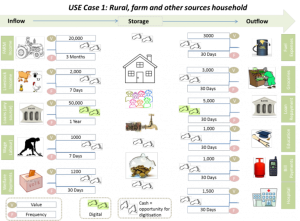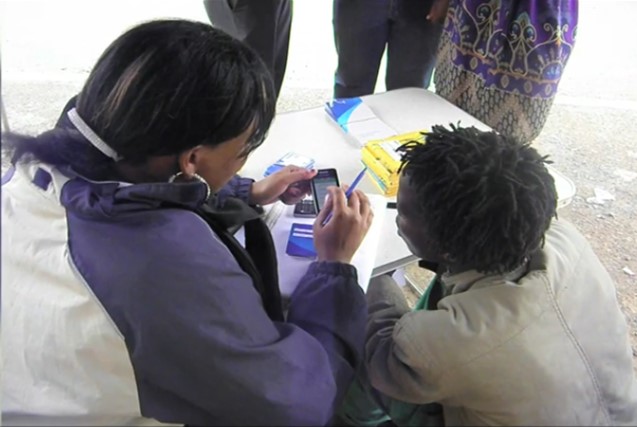There is probably a value proposition for both MFIs and Digital Financial Service Providers to partner with each other to facilitate the delivery of financial products and services. There are several ways in which these partnerships can work. In this video, MSC’s DFS expert, Denny George, examines some of these partnership modes from MFIs’ perspective.
Blog
Why m-wallets won’t work… yet!
As you might expect, India has more competing mobile network operators (12) than any other country and is only slightly behind China for subscribers (~894 million). It is widely acknowledged as the fast growing mobile market in the world.
India is also acknowledged as one of the most problematic anywhere for financial inclusion, particularly in the ~600,000 rural villages which have only ~33,500 commercial and regional rural banks—or one bank branch per 14,000 customers. The Reserve Bank of India (RBI) data confirms that more than 145 million families, close to half the population, have no access to formal banking services.
The solution seems obvious. The mobile operators, especially the top three (Airtel, Reliance, and Vodafone, each with a healthy respective market share of over 20% ), should provide mobile wallets and banking to the more than half billion who have no account, or only frustrating and limited access to local bank branches.
In addition to enabling more and better savings, credit, electronic money transfers, and payments, mobile wallets can also help operators reduce customer churn rate (every network’s worst fear in a highly competitive market), plus the new m-wallet/banking marketing campaigns for these low-income targets can boost overall financial capability. (Please see MicroSave’s recent blog on Rethinking financial education and a note on Marketing Lessons).
Everyone benefits. But nothing is simple, and in India, really nothing is simple.
The first problem, no surprise, is regulatory red tape and long delays. “Open” mobile wallets—i.e. not sponsored directly by a bank—all need to be linked to a bank account anyway. (For more on India’s bank-led financial inclusion model, and the unhappy symbiosis between banks and telecoms in general, please see MicroSave’s recent blog, Why is the Chicken Afraid to Cross the Road? )
And bank accounts don’t happen for wallets without a comprehensive authentication–Know Your Customer (KYC)–process. Most bank branches have figured out ways to streamline KYC for a normal or no-frills account to one or two days. Mobile operators can have your new phone ready to use in less than 24 hours. In highly competitive markets, the process is even faster. But wallets are a new and uncertain hybrid that no one fully trusts yet—and authentication turnaround time of up to two weeks does nothing to help inspire greater confidence.
MicroSave’s on-site observations for a leading mobile operator indicate preliminary paperwork is probably the first and worst hurdle to clear. Prospective wallet customers do not fill out or have help filling out their application forms in a bank branch under the watchful eye of a teller. Forms are completed in the busy local shops of bank agents. Many applicants are illiterate and, as one researcher explains, “The agent instructs them to either sign or put thumb impressions in the requisite places of the account opening form. And then rest of the form is filled in either by the agent, other staff, or super agent [regional network manager]—or, in several cases, by no one.”
BCs receive commissions on the number of new accounts they activate, not on the number of mistakes and incomplete answers they catch on the forms. So the banks return the forms as invalid, the forms wait around in the agents’ shops for the prospective wallet customers to return, and the KYC process begins anew. (Or the invalid forms get lost somewhere en route and/or BCs have no way of tracking down the applicant.) Two-week turnaround time begins to make more sense.
Another complication are the various cross-platform audits and hierarchies which include agents à super agents (BC network managers) à bank managers à mobile network managers…and then back down the chain to the prospective customer. Rural India is not renowned for instant and highly efficient delivery systems, but the impressive surge in internal remittances in many regions has increased everyone’s expectations and demands for speedier processing and problem resolution.
Possible solutions include:
- Better agent training for these applications
- Incentives for precision and correct fulfillment, in addition to the new-account catalysts
- Closer monitoring by their managers for accuracy and completion
- Daily electronic updates for the MNO wallet sponsors on their applications’ progress or lack thereof (on the premise that the operators care a lot more than the banks whether these wallets actually materialize or not)
Ultimately new ideas like mobile wallets work because they fulfill a need. The need is clearly there for many in India—with and without access to banking services—but any new idea involving money has to work perfectly and inspire full trust before anyone will adopt it. Mobile wallets have more to address than simply increased marketing and advertising to succeed with the many customers who need what they are selling.
Water and Sanitation Loan Products for MFIs
This video explores the new area of WatSan financing as a potential segment for MFIs. MSC’s Senior Analyst, TVS Ravi, highlights the demand for improved water and sanitation across the world and what role microfinance can play in improving access to water and sanitation. The major issues which MFIs have to keep in mind before entering WatSan financing are also mentioned.
Mobile Insurance: The need for value alignment
Mobile insurance is emerging as the newest distribution in insurance and microinsurance. In this podcast, MSC’s expert Premasis Mukherjee (Microinsurance domain) discusses the possibilities and challenges of mobile insurance including over the counter and bank-agent based distribution channels across the globe.
He emphasises that a mobile insurance product or programme can sustain only if there is a value alignment for all the stakeholders in its eco-system. A successful mobile insurance programme can emerge only if the product provides value to all the stakeholders as well as address the real and potential issues at the level of each of the stakeholder.
Towards De-risking disasters
In this report, MicroSave’s Microinsurance experts, Premasis Mukherjee and Sunil Bhat, study the potential for scaling up index-based disaster insurance for South and South Asian countries.
Follow the money approach: Introducing a powerful strategy tool for your mobile money/banking initiatives (Part I)
Let us start with a quick reality check. Most financial service institutions aspire to gain a bigger share of the client’s wallet not only in terms of profit but also the value and number of transactions with them. This is true irrespective of whether you are a single, double or triple bottom line institution. Those in the digital financial services space are of course no different. That brings us to some core and high-level strategic questions for those involved in developing a strategy for their financial services institutions: 1) What do you (as an institution) need to do to gain a bigger share of client’s wallet? 2) How do you dominate the market on a sustainable basis? All institutions try to answer these fundamental questions in one or other form (albeit a bit more specific and contextual) as they think about their strategy.
This two-part blog introduces the framework/approach which MicroSave has used with some institutions to help them answer these questions through a quick exercise. Let us call it, ‘Follow the Money Approach’ (FMA). It has proved to be very effective irrespective of what stage of life cycle these institutions are at; whether they are developing their go to market strategy, whether they are just revisiting their strategy or they are trying to expand. Following are some of its key benefits:
- It helps you understand and clearly see your target customer’s financial world from a transactional as well as from a financial ecosystem perspective.
- It lays out a pictorial map of the potential user’s financial ecosystem in terms of money coming in, staying and money going out.
- Once that is done, it also helps institutions, based on an understanding of their market and their unique situation, strategize and prioritize on what type of transactions to digitize.
- And, ultimately it provides an informed and clear strategic foresight on what to focus on in the short, medium and long run.
In simple terms, this helps you put your mouth where there is money.
There are four key steps towards a successful implementation of the FMA approach:

The following is a detailed ‘how to’ explanation for each step. We will cover the first two steps in the first part of the blog and the remaining two steps in the second part.
Step one: Identify your users and user categories
The objective is to understand different use cases of your offering more than doing a rigid categorization of a fluid client base into narrow segments. And, the ultimate objective is to find high potential intervention points for you to covert a cash footprint into digital footprint or to convert an existing inefficient digital footprint (such as interbank cheque transfers or expensive money transfer system) into a more efficient (for yourself, your agents as well as for the end users) digital footprint.
First activity within this step is to brainstorm and identify your key user types or client segments. Following is a sample categorization of use cases:

There are a few useful guiding points to help you come up with a dynamic categorization:
- Identify top livelihood activities: The categorization should be based on a solid understanding of the market in terms of the top livelihood activities for your market segment.
- Household as a unit of analysis: It is best to consider household/family as a user type and not an individual. It is because, in most cases, a household is the central processing unit for the majority of monetary transactions as well as decisions. And, of course, money is fungible between different sources/types of inflows. It makes the equation or analysis a bit more dynamic, vibrant and broad-based and, most importantly, realistic.
- Multiple livelihood sources: And, in almost all cases, households have multiple sources of income and inflows. Therefore your categories should not be focussed on a single livelihood source. Considering that, it is best to define your categories by putting the primary source of income first followed by a secondary source of income and/or other key attributes of this category.
- Number of categories: Optimally, one should have a minimum of 2-3 user segments to a maximum of five user segments.
Step two: Follow the money and map its footprint
The main objective here is to draw a unique Financial Footprint Map for each user segment.
Once the user types are identified, the next activity is to hit the ground, identify a few random households for each category (ideally 5-7 households per category) and engage in detailed qualitative conversations with the user segments.
Under this step, all you have to do is follow the money, map its footprints and organize these footprints in a logical structure. In any active financial ecosystem, you will inadvertently observe that money (whether cash or digital) has the following logical (as well as practical) trial as it leaves it footprints:
- Money comes in (Inflows): Money has to come in from somewhere. All inflows such as income from the farm, loan from bank or remittance from a family member fall under this category. As discussed there are often multiple sources and it is actually best if an institution starts with capturing/digitising at least one or two key inflows and bringing them into their fold. Include questions around how much and how often.
- Money stays (Storage): Money has to stay somewhere. A household often uses several mechanisms, formal as well as semi-formal/informal, to store their money. The basic savings/deposit account falls under this category. Most banks in India have only focussed on this product for their financial inclusion initiatives. In the following sections, we will see why is it important to move (and quickly so) beyond this minimalistic approach. Include questions around where and how long does it stay (in the bank or household).
- Money goes out (Outflows): Money has to go somewhere. All payments, purchases, fees, and expenses fall into this category. Include questions around how much and how often.
The Financial Footprint Map, as an outcome of this exercise, should ultimately look like this:

A couple of useful points to remember during this step:
- Though each household would be different even within the same categories, that should not be a concern, as the broad idea/objective is to understand the most popular types of (high value and/or high frequency) irrespective of use cases. The use cases allow you to see things from a bit more holistic and realistic standpoint instead of just focussing on different types of transactions.
- Try and include as many transactions as possible. It is not advisable to filter at this stage as we will do so in the next step.
Once you have a financial footprint map ready, it is time to move to step three.





